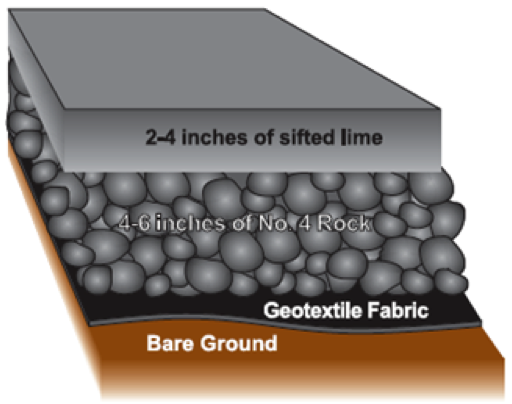 A high-traffic area pad or feeding pad consists of geotextile fabric, No. 4 crushed stone and a dense grade aggregate installed over an excavated area.
A high-traffic area pad or feeding pad consists of geotextile fabric, No. 4 crushed stone and a dense grade aggregate installed over an excavated area.We all know the feeling when you lift your foot to take a step and suddenly realize that your boot has been left behind and your soaked foot is half a step away from it in ankle-deep mud. Mud is a problem anywhere water meets bare soil. During the last few years, Kentucky horse farms have had their share of mud.
Horses, like humans, are creatures of habit and return to the same areas repeatedly. This behavior causes over-grazing and trampling that will inevitably reduce grass coverage and result in muddy areas. Recent extreme weather conditions have further thinned Kentucky pastures, magnifying the mud issue. Mud is not only unattractive, it is dangerous for horses and people, harbors bacteria and decreases pasture productivity.
There are several pasture management tools that can help reduce mud and the dangers and difficulties associated with it.
Overseeding
Overseeding heavy traffic areas can prevent or correct mud issues, and depending on how you do it, can be a long-term solution or a short-term, simple fix. The ideal method is to remove horses from the paddock or fence off an area, then seed into a prepared seedbed or killed sod with perennial grasses like Kentucky bluegrass, orchardgrass, and endophyte-free tall fescue. This does require equipment and enough time for the seedlings to fully establish, often six months or more, but results in a permanent pasture last for many years.
Perennial and annual ryegrass provide short-term options for horse owners that are quick to establish and relatively inexpensive. Annual ryegrass will establish very quickly and is inexpensive; however, annual ryegrass will only survive to mid-summer. Perennial ryegrass survives for about two years in Kentucky if not overgrazed, but is a bit more costly and slightly slower to establish. Unlike other cool season grasses, ryegrasses can be broadcast on top of the ground and will still germinate and take root. In small, high-traffic areas, this may be the simplest method to manage mud.
Keeping horses and people off of this area as long as possible is best, so consider moving the hay rack, water tank, or using a different gate until the root is established. Broadcast seeding of other forage species (Kentucky bluegrass, orchardgrass, etc.) will not be successful unless the area is dragged or cultipacked after seeding to bury the seed. Even when overseeding ryegrass, dragging is recommended.
Success of any overseeding application depends on several factors including time of seeding, seed quality and soil fertility. Always purchase certified seed of improved varieties and consider a soil test before seeding. Make sure to use endophyte-free perennial ryegrass, since turf-type perennial ryegrass contains an endophyte similar to tall fescue that can create problems for pregnant mares. Early March is the best time for spring overseeding in Kentucky.
High-Traffic Area Pads
In some cases, seeding will never provide enough relief from mud. Paddocks with only one gate or water source constantly face issues with mud, especially when over stocked. In these cases, high-traffic area pads are a useful option. These pads do require some investment; however, they will reduce or eliminate mud for years to come.
A high-traffic area pad or feeding pad consists of geotextile fabric, No. 4 crushed stone and a dense grade aggregate installed over an excavated area. The result of such material is a pad of smooth dry surface similar to concrete. The geotextile fabric prevents mud from seeping up into the pad and eventually engulfing the area again. Typically, poured concrete will cost around $4 per square foot. The University of Kentucky Biosystems and Agricultural Engineering Department estimated the cost of a high-traffic area pad around $0.80 per square foot.
High-traffic area pads can be installed anywhere that equine or machine traffic is too high to establish cover, including around gates, water/feed sources and along fence lines or shade areas.
Preventing Mud in the Future
Mud prevention requires long-range planning and a balance between managing horses and managing pastures. Establishing a sacrifice area is a simple way to decrease pasture damage during times of heavy moisture or excessive drought. A sacrifice area is similar to a dry lot that will provide an alternative turn out space to pasture. Ideally, the sacrifice area should be prepared similarly to the high-traffic pad as described above.
Pasture rotation is one of the simplest ways to avoid mud issues. By giving a pasture a rest period, bare soil will often be reduced naturally. When paired with overseeding, it will provide a greater increase in cover. Pasture rotation only requires two paddocks, but three or more are recommended to provide each paddock with longer rest.
Ray Smith, PhD, is a forage extension specialist at the University of Kentucky. Krista Cotton is the assistant coordinator of UK’s Horse Pasture Evaluation Program.
More Information
The University of Kentucky has several publications related to managing mud. Please see the list of publications below for more information. These publications, as well as other pasture related information, can be found at www.uky.edu/Ag/forage with equine-specific publications listed under “Equine.” Some publications you might want to download include:
- High Traffic Area Pads for Horses (ID-164) Higgins, Koostra, Workman, Gallagher and Coleman.
- Maintaining Healthy Horse Pastures Teutsch (Virginia Tech) and Smith (University of Kentucky).
- Establishing Horse Pasture (ID-147) Smith, Lacefield, Schwer, Witt, Coleman and Lawrence.
Contact your local county agriculture and natural resource agent with specific questions or issues.
This information is reprinted from the University of Kentucky College of Agriculture. Some of the grass selections mentioned here might not be appropriate for other parts of the country. Contact your county extension agent for advice on pasture management in your area.



